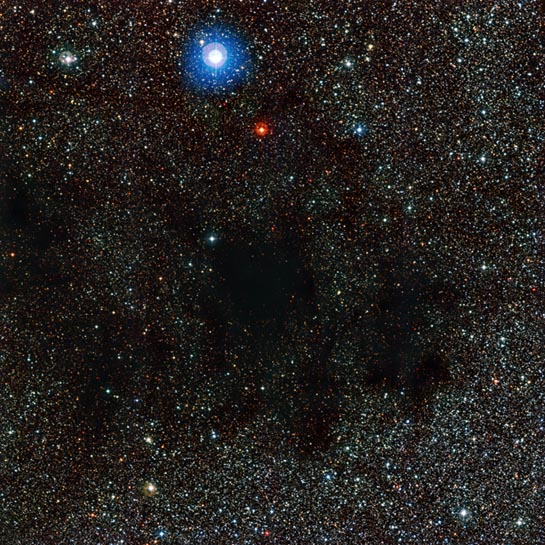
Dark Nebula, Molecular Cloud
RA 12h 31m 24.42s Dec -63° 45' 35.15"
Crux
600 light years
34.02 x 37.71 arcminutes
North is -0.0° left of vertical
ESO
October 14, 2015
ABOUT THIS IMAGE:
Dark smudges almost block out a rich star field in this new image captured by the Wide Field Imager camera, installed on the MPG/ESO 2.2-meter telescope at ESO’s La Silla Observatory in Chile. The inky areas are small parts of a huge dark nebula known as the Coalsack, one of the most prominent objects of its kind visible to the unaided eye. Millions of years from now, chunks of the Coalsack will ignite, rather like its fossil fuel namesake, with the glow of many young stars.
The Coalsack Nebula is located about 600 light-years away in the constellation of Crux (The Southern Cross). This huge, dusky object forms a conspicuous silhouette against the bright, starry band of the Milky Way and for this reason the nebula has been known to people in the southern hemisphere for as long as our species has existed.
The Spanish explorer Vicente Yáñez Pinzón first reported the existence of the Coalsack Nebula to Europe in 1499. The Coalsack later garnered the nickname of the Black Magellanic Cloud, a play on its dark appearance compared to the bright glow of the two Magellanic Clouds, which are in fact satellite galaxies of the Milky Way. These two bright galaxies are clearly visible in the southern sky and came to the attention of Europeans during Ferdinand Magellan’s explorations in the 16th century. However, the Coalsack is not a galaxy. Like other dark nebulae, it is actually an interstellar cloud of dust so thick that it prevents most of the background starlight from reaching observers.
A significant number of the dust particles in dark nebulae have coats of frozen water, nitrogen, carbon monoxide and other simple organic molecules. The resulting grains largely prevent visible light from passing through the cosmic cloud. To get a sense of how truly dark the Coalsack is, back in 1970, the Finnish astronomer Kalevi Mattila published a study estimating that the Coalsack has only about 10 percent of the brightness of the encompassing Milky Way. A little bit of background starlight, however, still manages to get through the Coalsack, as is evident in the new ESO image and in other observations made by modern telescopes.
The little light that does make it through the nebula does not come out the other side unchanged. The light we see in this image looks redder than it ordinarily would. This is because the dust in dark nebulae absorbs and scatters blue light from stars more than red light, tinting the stars several shades more crimson than they would otherwise be.
Millions of years in the future the Coalsack’s dark days will come to an end. Thick interstellar clouds like the Coalsack contain lots of dust and gas — the fuel for new stars. As the stray material in the Coalsack coalesces under the mutual attraction of gravity, stars will eventually light up, and the coal “nuggets” in the Coalsack will "combust", almost as if touched by a flame.
From Wikipedia:
The Coalsack Dark Nebula (or simply the Coalsack) is the most prominent dark nebula in the skies, easily visible to the naked eye as a dark patch silhouetted against the southern Milky Way. It is located at a distance of approximately 600 light years away from Earth, in the constellation Crux.
The Coalsack Dark Nebula covers nearly 7° by 5° and overlaps somewhat into the neighbor constellations Centaurus and Musca. The first observation was reported by Vicente Yáñez Pinzón in 1499. It was named “il Canopo fosco” (the dark Canopus) by Amerigo Vespucci and was also called “Macula Magellani” (Magellan's Spot) or “Black Magellanic Cloud” in opposition to the Magellanic Clouds.
In 1970, Kalevi Mattila proved that the Coalsack is not totally black. It has a very dim glow (10% of the brightness of the surrounding Milky Way), which comes from the reflection of the stars it obscures.
The Coalsack is not present in the New General Catalogue and in fact does not have an identification number (outside of the Caldwell Catalogue, in which it is C99).
The Coalsack is important in Australian Aboriginal astronomy and forms the head of the Emu in the sky in several Aboriginal cultures. Amongst the Wardaman people, it is said to be the head and shoulders of a law-man watching the people to ensure they do not break traditional law. According to a legend reported by W. E. Harney, this being is called Utdjungon and only adherence to the tribal law by surviving tribe members could prevent him from destroying the world with a fiery star. There is also a reference by Gaiarbau (1880) regarding the coalsacks replicating bora rings on earth. These astronomical sites allowed the spirits to continue ceremony similar to their human counterparts on earth. As bora grounds are generally located on the compass points north/south, the southern coal sack indicates the initiation/ceremonial ring.
In Inca astronomy this nebula was called Yutu, meaning a partridge-like southern bird or Tinamou.